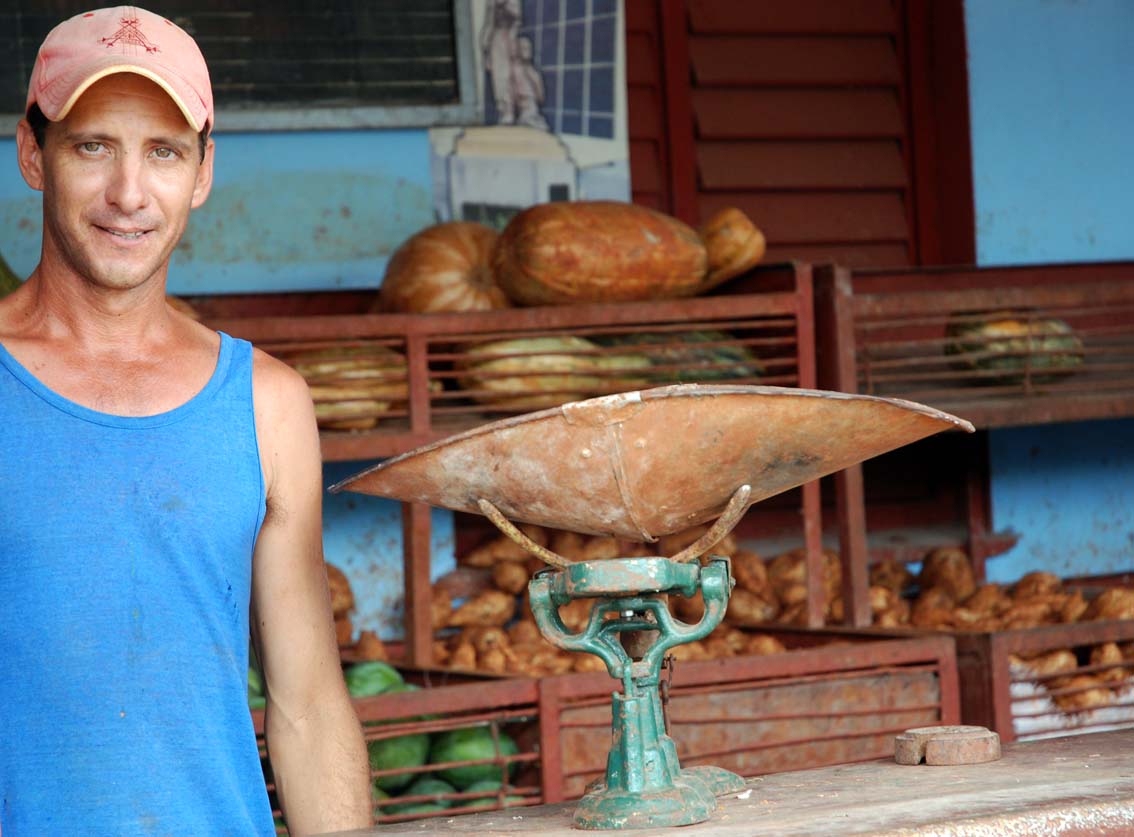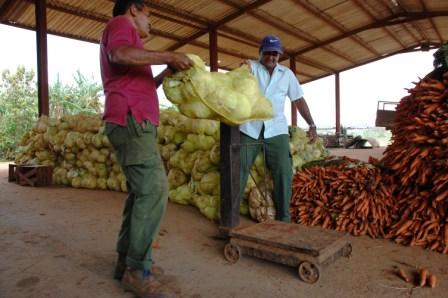Cuba’s Produce Market Maze
Lazaro Gonzalez

HAVANA TIMES, May 16 — “This market is always deserted. It’s a shame to stop in the street and look at it these days. It used to have everything, and good quality stuff.
Now there’s next to nothing and the produce is often horrendous,” commented an angry and exasperated customer of the State Agricultural Market in the Havana community of La Lisa.
Her complaints are not without foundation; over the last several months, putting a decent meal on the table now requires the talent of a Houdini for residents of the Cuban capital.
Yolanda Aguilar, a retiree who frequents the State market at 26th and 41st streets, in the Nuevo Vedado neighborhood, complained about the scarcity of many fruits. “They’re invisible,” she said.
“Occasionally I have to go to the ‘expensive markets’ to buy them, because they’re disappearing.” Since their resurgence in 1994, the independent and non-priced-controlled “supply and demand markets” have been popularly dubbed los caros (the expensive ones). Their astronomical prices have spawned more than a few detractors. “Those ones, yeah, they’re always well stocked. Occasionally I go there to look for what I can’t find here, things like malanga and fruit; but other times the prices don’t let me,” pointed out Eddy Diaz, a shopper at 26th and 41st market who regularly keeps his eye on the quality of State products and criticizes how “they almost always sell them at first-class prices though the quality is third rate.”

A retiree who shops at the two types of markets in the Marianao neighborhood, Leonarda Ricardo, assured that: “The prices in the State markets are criminal because the quality is awful, while in the independent ones there’s everything and the quality is divine – though the prices are through the roof. Why do the independent ones have wonders and the State ones have nothing? That’s the question everyone is asking,” she commented.
The flip side of the coin
“The lack of supply is due to the lack of production,” responded Lorenzo Rober, who has worked as a vendor at the State market on 26th and 41st streets for a decade.
“The quantity is good enough, but there’s very little variety, especially in terms of grains and fruits. When we bought produce from the farmers directly, the selections were better,” he noted. Mykel Vega, a young administrator at the same price-controlled agro-market, stated that the situation improved considerably when they began buying from urban agriculture cooperatives to supply the market. Now they receive fresh vegetables early, direct from the field.
“We have shortages with root vegetables and plantains, but generally an improvement can be noticed in the distribution. Better harvests are what’s necessary. If we advance in terms of production, the sales and commercialization would align perfectly, because this system is very well designed,” added Vega.
Since August 2009, a new centralized system of commercialization has been experimented with in two Havana provinces (Havana City and Havana Province), though this has generated much dissatisfaction among producers, consumers and officials in charge of distribution.

In its test phase, and with the perspective of this being generalized across the whole country, the current design in essence prohibits farmers from selling their products directly to the vendors in State markets. It multiplies the intermediate links several times over and concentrates the responsibility of distributing the goods within the Ministry of Domestic Trade (MINCIN), a process which —in theory— is more equitable and saves fuel.
In practice, however, the movement of produce between the field and the dinner table has become slow and complicated, engendering considerable losses due to waste, theft and misappropriations at several points along the chain, productive imbalances and irregularities in the use of transportation, including the misuse of fuel.
Alexander Bejerano, the administrator of a State market in western Havana’s La Lisa community, thinks it is necessary to review the relationship between the farmers, the Ministry of Agriculture and the MINCIN companies. “It’s very sad, embarrassing and inconceivable to have products in warehouses but the public can’t acquire them.” Leosdan Capote, a vendor at the same agro-market, finds that “the change has not borne fruit. There’s production sure, because independent markets have something of everything. But as for those of us who sell to working people, we have very little.”
No chicken in the chicken soup
According to Jorge Luis Tillet, the deputy administrator of the Plaza de Marianao supply and demand market, with 10 years of experience, “The trucks should supposedly arrive at these markets with surpluses, after having fulfilled a State delivery plan. This is completely violated, it’s common knowledge and admitted by everybody. If this were carried out properly there would be the quantity and necessary variety of produce in the State markets.” 
A different opinion is held by some managers and workers at the independent mercados de libre formación de precio (markets at unregulated prices); they believe that the “missing chicken in the chicken soup” results not from the diverting of produce that would otherwise be directed to the community markets, because these sell only a small part of what is produced.
This appears to be true, since in accordance with data from MINCIN, the 33 unregulated markets in the city of Havana sell barely nine percent of the agricultural products sold in the capital.
Around 50 tons of products daily compared to some 500 tons sold in the 310 capped-price State markets. The independent markets are better supplied than the price-restricted State markets due only to the mechanism that governs them, said Jose Gascon, a 15-year veteran vendor at the Plaza de Marianao market.
“The producer comes here with their papers in order, they supply their products and payment is made directly, in cash,” he said. “We can’t remain unaware of the effects of the drought and production problems,” he recognized. “But if to those we add the human factors that hinder distribution, the situation becomes aggravated,” he noted.
“The State commercialization mechanisms have their margin of maneuver, but when one sees the errors they realize that these are products of that intermediary link in the chain that is not sensitive to the problems of the consumer. This business demands creativity, because the merchandise deteriorates quickly and people need it.”
“Food decides the Revolution. I’m a revolutionary and the things that are happening pain me,” complained Gascon with visible sincerity. “Everyone who comes here are common people, so it’s shameful that the independent markets offer a better option than buying from the State, which has the resources. Raul Castro said it: ‘Everything is in our hands’, so…why doesn’t it work?”






Engels & Marx sought to split the workers and small entrepreneurial class by spitting on the farmers & restauranteurs, calling them petty bourgeois reactionaries.
Besides handing the peasantry over to the manipulation of the big banks & industrial bourgeoisie, this prejudice against the small bourgeoisie has ruined agriculture in every country where an anti-capitalist party has come to power.
All Cuba needs to do in order to revitalize her agricultural sector is dump the Marxian nonsense & follow the Denmark cooperative model–which model began in the latter 1800s. This model needs private property rights and the trading market.
By giving farmers legal title to the land, helping them obtain what they need, allowing them to cooperate among themselves to obtain cheaper economic inputs and market their produce for higher prices, the small farmers could quickly make Cuba a very prosperous country.
Unfortunately, Cuba seems doomed to Marxian bureau paralysis.
If it’s more efficient 2 1st concentrate produce in 1 or a few distribution centers in a city with an intermediate (thus bureaucratic) collection process — rather than simply allowing the former ‘free-4-all’ of direct buying 2 continue — this also implies *direct democratic control of the process by all parties involved* if it is 2 B a socialist system of distribution. So if all the produce of all quality — good, mediocre & bad — is concentrated in 1 or a few places, it should then B equitably distributed among all the neighborhood markets — & none of it allowed 2 B siphoned off by the petit-bourgeois entrepreneurs, as is inevitable under a capitalist logic & system. That is how socialism is directly subverted.
The only way 2 guarantee the process’ efficiency is 4 all the groups involved 2 meet formally & regularly 2 hammer out all differences, all the time. @ least until everything runs smoothly, hopefully. & then other, larger issues can B addressed, etc.
I want to add, too, that the citizenry of each neighborhood should have democratic control over how exactly such institutions as the local produce markets operate. Look at how much effort is wasted by each individual family, looking for decent produce, day after day, independently of each other. Everyone for himself. Instead, you would create huge “efficiency” savings right there, by keeping close collective control over the price and quality of the produce at the local markets — and further along the supply chain. So if e.g. the quality of the produce doesn’t justify the prices, for instance — well; then the neighborhood council should know the reasons *why*. Pronto. And this issue should then immediately become a *political* issue, to be passed up the political ‘food chain’.
And that would be efficiency itself, IMO AFAIC.
“Economies of scale” only work when they R appropriate 4 the situation — & R executed properly. Here it looks like, instead of the direct & almost-instantaneous feedback of a well-planned socialist agricultural workflow from field 2 table, U have added yet another layer of unaccountable, unwieldy, unresponsive bureaucracy — as U point out. So if agricultural production in Cuba is/was being so intensively addressed up & down the supply chain, why would there B the need 4 petit-bourgeois enterprise 2 fill-in the ‘inefficiencies’ of the system..? Methinks U should B concentrating efforts on the public markets entirely. & AFAIC each neighborhood deserves its own market — on top of the function of larger farmers’ markets. Think “Mercal” as in Venezuela…